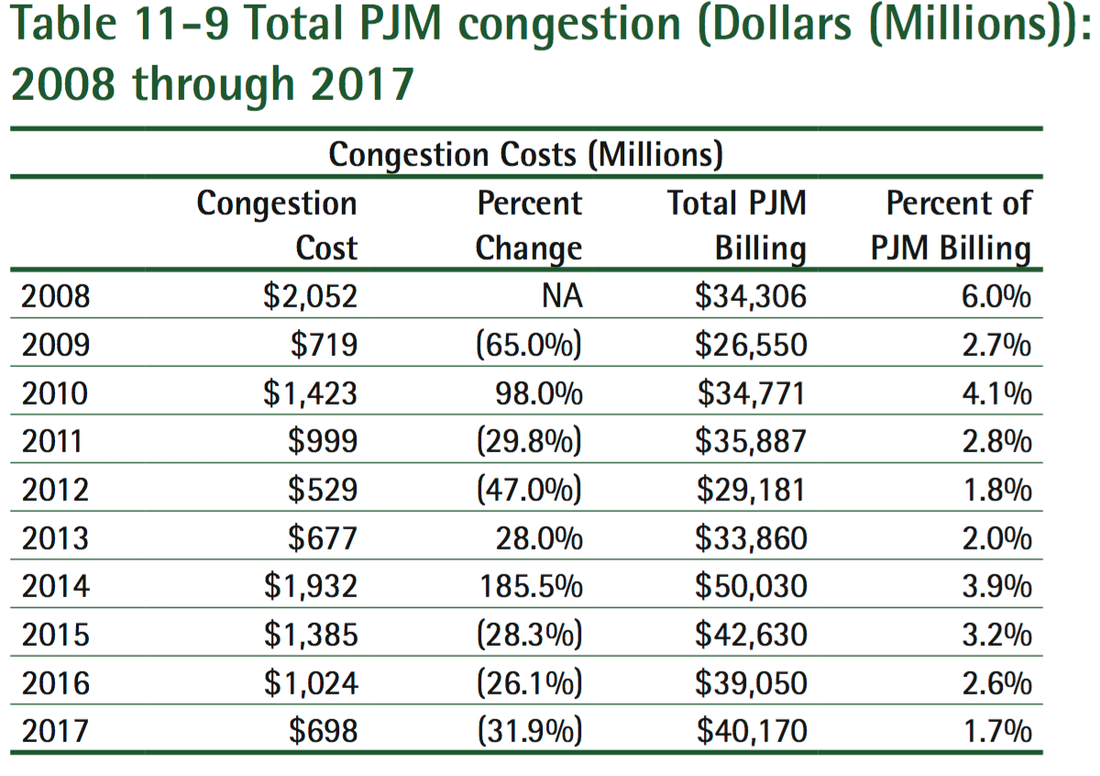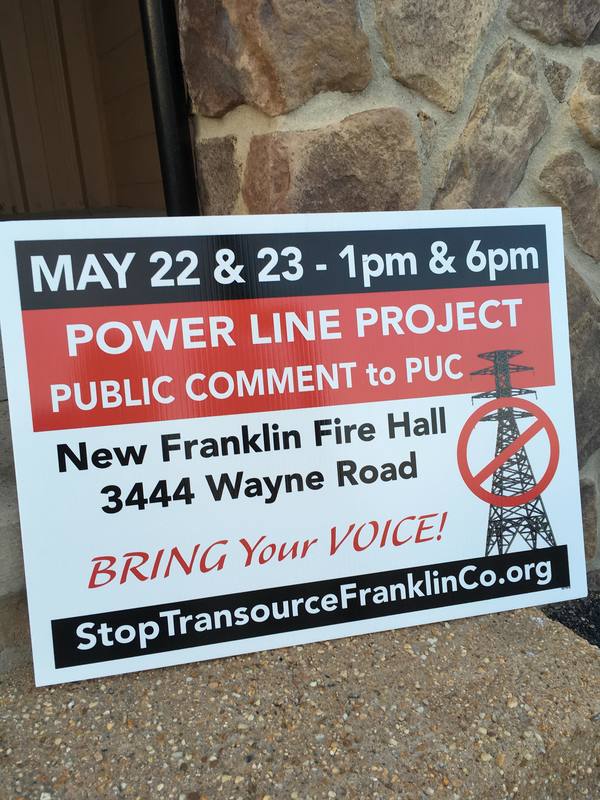Let's start with Steve Herling's Op Ed in the York Dispatch, since it inspired a bunch of new public comment in opposition to the project yesterday in Franklin County. Mr. Herling's Op Ed is a distinct contrast to what he said during the TEAC meeting on September 13. But if you didn't attend that meeting (or listen in over the phone) you might not realize how much doublespeak it contains.
Mr. Herling starts out recognizing there is "public interest" in the project. He thinks it's a recent development. It's not, not at all. The public has been concerned about this project since it was brought to their attention more than a year ago. Opposition was overwhelming and immediate. Mr. Herling just hasn't been paying attention until now, when it's becoming more of a likelihood that this project will be denied by the states. Too little, too late, Mr. Herling!
Trying to explain PJM's purpose and the project's necessity to the public at this late stage is like trying to bail out the Titanic with a tea cup. Good luck with that, but chances are the ship is going down and if you don't scurry to the lifeboat, you're going down with it.
Mr. Herling thinks he's making the electrical system efficient, economical and equitable (alliteration at its finest, probably not the work of Mr. Herling but some PR wordsmith).
After all, it would not be fair for customers in one area to consistently pay higher prices than others do simply because the system’s design prevented some customers from accessing the lowest-cost electricity.
For many years, some customers in the mid-Atlantic region, those in areas of Maryland, Northern Virginia and the District of Columbia, have had to pay comparatively higher prices than customers in other areas have, because bottlenecks in the interstate transmission system have not allowed an efficient flow of the lowest-cost power into the zone.
You mention the authority of the Federal Energy Regulatory Commission like they approved this project. They did not. It's not even on their radar. FERC has nothing to do with transmission siting and permitting. FERC's only jurisdiction is over interstate transmission rates, and that has not become an issue with Transource... yet. FERC's jurisdiction does, however, extend to the actions of PJM. FERC expects PJM to follow its own FERC-approved manuals and tariffs while it conducts its business. Maybe Mr. Herling should look a little closer to home when talking about the authority of FERC, to make sure he's crossed all his t's and dotted all his i's. What does PJM's operations manual say about annual re-evaluations of market efficiency projects... and what information must PJM include in just such an analysis? Maybe Mr. Herling should be saving up his doublespeak for FERC.
And then he says this:
PJM recently completed its annual review of the Transource project. Our thorough analysis of the many factors that go into benefits and costs concluded that the benefits continue to justify the costs.
The analysis considered factors such as recent load and congestion forecasts, current cost estimates, power flow projections, topology, interregional modeling, future fuel prices and generation interconnections.
The issue of generation interconnections also came up at the TEAC meeting. Mr. Herling admitted that PJM did not use recent retirements in its analysis, and did not include new generation either.*
And then there's the whole reliability issue that first appeared on PJM's analysis of September 13.
During our recent review, PJM found that the Transource project also will address significant reliability issues that are emerging on the regional transmission system, including the potential overload of a key high-voltage line that carries electricity across the Pennsylvania-Maryland border.
Without the additional transmission capacity provided by the Transource project, the system could face serious violations of federal reliability standards, which would require additional measures to address.
And here's Mr. Herling repeating Transource's most recent lie:
The interstate high-voltage transmission system is a shared resource, and consumers including homeowners, tenants, businesses and industrial plants throughout the PJM footprint benefit from a robust network that provides reliable and affordable electricity across the region.
The idea of new transmission in one part of PJM benefiting the entire region is one that has a long and tortured history in the courts. Circa 2005, in order to set up a way to spread cost recovery for big projects over as many people as possible in order to make everyone's share less noticeable, PJM began using a "postage stamp" method of cost allocation for a suite of big projects code named "Project Mountaineer." These four projects were intended to increase the export of coal-fired electricity from the Ohio Valley to eastern PJM cities by 5,000 MW. Under the postage stamp method, every utility in PJM was assigned a portion of the costs based on its percentage of load for the prior year. PJM and FERC reasoned that every part of the system received some benefit from these new projects in eastern PJM, although they could not quantify these benefits. Some utilities in the western part of the region, who were paying a large percentage of the costs due to their load, believed they were not receiving a corresponding amount of benefit. The case ended up before the 7th Circuit, who remanded it back to FERC (twice!) requiring FERC to quantify the benefits, at least roughly. It never happened. Instead, FERC and PJM devised a new cost allocation scheme where ultra high voltage projects (double-circuit 345kV, 500kV and 765kV) would be allocated 50% postage stamp and 50% DFAX, where cost causers and beneficiaries are assigned costs commensurate with their use of the project. In one memorable analogy from the 7th Circuit's opinion, it was said:
The incidental‐benefits tail mustn’t be allowed to wag the primary‐benefits dog.
The fact of the matter is that York County does not benefit at all from the IEC. Not one penny! And it probably didn't benefit from a project in Indiana either. Whether or not Franklin County benefits from the IEC is debatable. Have PJM's cost allocations changed in relation to the IEC's cost/benefit analysis? No, they haven't. And they won't. The cost responsibility analysis is locked in time, although if updated today it may have very different results. And here's the ultimate bottom line... Franklin County does not benefit anywhere near commensurate with the sacrifice it is being asked to make.
Mr. Herling says stakeholders need to "understand" the project's purpose and benefits. As if maybe they finally "understood," then opposition would subside? Fat chance, Mr. Herling. Your attempt at the Information Deficit technique doesn't work. It is precisely because the "stakeholders" DO understand the rhetoric and hubris of PJM, and the profit-seeking motives of Transource, that they oppose this project. And these stakeholders aren't going away. They're going to be in your face until you do the right thing.
About the only thing in Mr. Herling's opinion I can agree with is that applications for the Transource project are now under consideration by the Maryland Public Service Commission and the Pennsylvania Public Utility Commission. And I believe the commissions also fully "understand" what this project is about. Ultimately, the states have the final say here, and you're not helping yourself out by saying one thing and doing another, and ignoring a recent PA-PUC Order for Transource to update its costs before your recent analysis. That was a pretty bold move. Don't think the regulators are buying your doublespeak.
And, ultimately, because of PJM's refusal to acknowledge that the IEC isn't going to happen, it's enabling Transource to run up our tab unnecessarily. The one thing missing from Mr. Herling's Op Ed is the fact that PJM serves consumers, not member utilities. Guess Mr. Herling needs to "understand" that.



 RSS Feed
RSS Feed